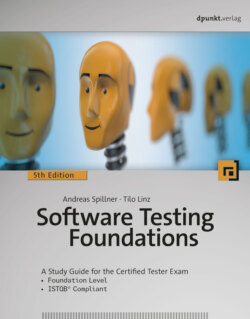Читать книгу Software Testing Foundations - Andreas Spillner - Страница 8
Contents
Оглавление1Introduction
2Software Testing Basics
2.1Concepts and Motivations
2.1.1Defect and Fault Terminology
2.1.2Testing Terminology
2.1.3Test Artifacts and the Relationships Between Them
2.1.4Testing Effort
2.1.5Applying Testing Skills Early Ensures Success
2.1.6The Basic Principles of Testing
2.2Software Quality
2.2.1Software Quality according to ISO 25010
2.2.2Quality Management and Quality Assurance
2.3The Testing Process
2.3.1Test Planning
2.3.2Test Monitoring and Control
2.3.3Test Analysis
2.3.4Test Design
2.3.5Test Implementation
2.3.6Test Execution
2.3.7Test Completion
2.3.8Traceability
2.3.9The Influence of Context on the Test Process
2.4The Effects of Human Psychology on Testing
2.4.1How Testers and Developers Think
2.5Summary
3Testing Throughout the Software Development Lifecycle
3.1Sequential Development Models
3.1.1The Waterfall Model
3.1.2The V-Model
3.2Iterative and Incremental Development Models
3.3Software Development in Project and Product Contexts
3.4Testing Levels
3.4.1Component Testing
3.4.2Integration Testing
3.4.3System Testing
3.4.4Acceptance Testing
3.5Test Types
3.5.1Functional Tests
3.5.2Non-Functional Tests
3.5.3Requirements-Based and Structure-Based Testing
3.6Testing New Product Versions
3.6.1Testing Following Software Maintenance
3.6.2Testing Following Release Development
3.6.3Regression Testing
3.7Summary
4Static Testing
4.1What Can We Analyze and Test?
4.2Static Test Techniques
4.3The Review Process
4.3.1Review Process Activities
4.3.2Different Individual Review Techniques
4.3.3Roles and Responsibilities within the Review Process
4.4Types of Review
4.5Critical Factors, Benefits, and Limits
4.6The Differences Between Static and Dynamic Testing
4.7Summary
5Dynamic Testing
5.1Black-Box Test Techniques
5.1.1Equivalence Partitioning
5.1.2Boundary Value Analysis
5.1.3State Transition Testing
5.1.4Decision Table Testing
5.1.5Pair-Wise Testing
5.1.6Use-Case Testing
5.1.7Evaluation of Black-Box Testing
5.2White-Box Test Techniques
5.2.1Statement Testing and Coverage
5.2.2Decision Testing and Coverage
5.2.3Testing Conditions
5.2.4Evaluation of White-Box Testing
5.3Experience-Based Test Techniques
5.4Selecting the Right Technique
5.5Summary
6Test Management
6.1Test Organization
6.1.1Independent Testing
6.1.2Roles, Tasks, and Qualifications
6.2Testing Strategies
6.2.1Test Planning
6.2.2Selecting a Testing Strategy
6.2.3Concrete Strategies
6.2.4Testing and Risk
6.2.5Testing Effort and Costs
6.2.6Estimating Testing Effort
6.2.7The Cost of Testing vs. The Cost of Defects
6.3Test Planning, Control, and Monitoring
6.3.1Test Execution Planning
6.3.2Test Control
6.3.3Test Cycle Monitoring
6.3.4Test Reports
6.4Defect Management
6.4.1Evaluating Test Reports
6.4.2Creating a Defect Report
6.4.3Classifying Failures and Defects
6.4.4Defect Status Tracking
6.4.5Evaluation and Reporting
6.5Configuration Management
6.6Relevant Standards and Norms
6.7Summary
7Test Tools
7.1Types of Test Tools
7.1.1Test Management Tools
7.1.2Test Specification Tools
7.1.3Static Test Tools
7.1.4Tools for Automating Dynamic Tests
7.1.5Load and Performance Testing Tools
7.1.6Tool-Based Support for Other Kinds of Tests
7.2Benefits and Risks of Test Automation
7.3Using Test Tools Effectively
7.3.1Basic Considerations and Principles
7.3.2Tool Selection
7.3.3Pilot Project
7.3.4Success Factors During Rollout and Use
7.4Summary
Appendices
AImportant Notes on the Syllabus and the Certified Tester Exam
BGlossary
CReferences
C.1 Literature
C.2 Norms and Standards
C.3 URLs
Index
